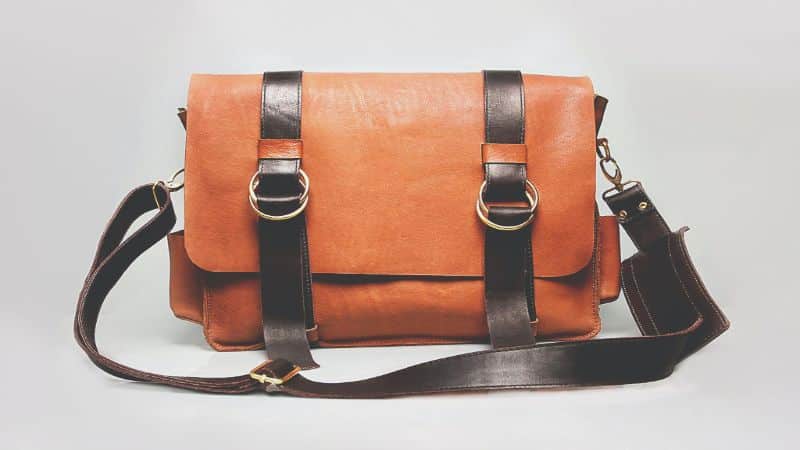Ever glanced at your once-favorite handbag and thought it’s seen better days? You’re not alone! Before you consider tossing it out, let’s give that beloved accessory a new lease on life.

With a touch of creativity and a few handy tricks, you can transform your old handbag into a stunning piece that looks brand new. It’s time to roll up your sleeves and breathe some fresh style into your trusty companion.
Assessing the condition of your handbag
Before diving into restoration, take a moment to evaluate your handbag’s current state. Identify areas that need attention – this could range from faded color to loose stitching. Here’s what specifically to look for:
- Surface Damage: Check for obvious signs of wear such as scratches, stains, or peeling. Determine if these are superficial or if they’ve compromised the bag’s material.
- Structural Issues: Inspect the bag’s shape and frame. Is it misshapen? Do the handles or straps show signs of strain?
- Functionality: Test all zippers and closures. Make sure they open and close smoothly. If there’s stiffness, note that down for potential lubrication.
- Interior: Turn your gaze inside. Look for tears in the lining or residue from old spills.
Use this table for a simple overview of what to address:
| Area | Condition | Action Needed |
|---|---|---|
| Exterior Surface | Faded/Peeling | Clean/Restore Color |
| Handles/Straps | Worn/Strained | Reinforce/Replace |
| Zippers/Closures | Stiff/Broken | Lubricate/Repair/Replace |
| Interior Lining | Torn/Stained | Clean/Replace |
Remember that some issues are easier to fix than others. Cleaning is straightforward but repairing a zipper might require professional help. Carefully considering the state of your handbag helps you set realistic goals for its revival. Go ahead, make those notes and prepare to bring back your handbag to its former glory.
Cleaning techniques for different materials
When you’re trying to revive an old handbag, knowing how to clean different materials is key. Leather, suede, canvas, and synthetic fabrics each require unique care.
Leather Handbags
Leather bags need gentle cleaning. First, wipe off dust with a microfiber cloth. For deeper grime, use a leather cleaner on a soft cloth. Circular motions work best. Hydrate the leather after cleaning with a conditioner.
Here are the steps for leather maintenance:
- Wipe with a microfiber cloth
- Apply leather cleaner sparingly
- Condition the leather to prevent cracking
Suede Handbags
Suede can be tricky. Brush with a suede cleaning brush to lift dirt and maintain nap. For stains, use a suede eraser. Water can ruin suede, so always clean dry unless the label says otherwise.
Quick suede tips:
- Brush with a suede-specific brush
- Erase stains cautiously
- Avoid water
Canvas Handbags
Canvas is more forgiving. Mix mild soap with water and use a soft brush. Gently scrub and rinse with a clean cloth. Air dry your canvas handbag away from direct sunlight to prevent fading.
Effective canvas cleaning involves:
- Mild soap and water
- Soft brush scrub
- Air drying
Synthetic Fabrics
Synthetics often withstand tougher cleaning. A solution of water and dishwasher liquid works well. Test a small area first. Wipe clean and air dry.
Handle synthetic handbags with these steps:
- Use water and mild dishwasher liquid
- Test on a small section
- Wipe and air dry
Remember to check the manufacturer’s care instructions before using any product on your handbag. Spot testing is always a smart move, regardless of the material. Each material has its quirks, but with the right approach, your old handbag’s beauty will reemerge.
DIY repairs and touch-ups
Once you’ve assessed your handbag’s condition and cleaned it thoroughly, it’s time to move onto repairs and touch-ups. Start with the essentials: stitching and hardware. Loose threads or a missing stitch can quickly escalate to a larger problem, so take care of these issues promptly.
For stitching:
- Re-thread a needle with matching thread.
- Secure loose ends with a double knot.
If hardware like zippers or buckles are tarnished or malfunctioning:
- Lightly rub with a metal cleaner or white vinegar.
- Ensure moving parts are well-oiled for smooth operation.
Scratches or scuffs on leather can be diminished using specialized products:
- Apply a leather conditioner to hydrate the material.
- Buff out minor scratches with a matching leather dye.
« How to Polish Leather Handbag: Achieve Long-Lasting Shine with These Tips
How to Name a Handbag Store: Unveil a Chic & Memorable Brand »
When dealing with peeling edges or corners:
- Adhere loose material with a leather glue.
- Clamp the area until it’s firmly reattached.
Don’t overlook the linings. Often, the interior suffers from neglect. Rips or tears in the lining can be hand-sewn or, for a quick fix, use fabric glue to seal edges. If pockets are frayed or holes have developed:
- Patch with a similar fabric for consistency.
- Sew around the borders to reinforce.
In dealing with discoloration, especially on lighter bags, a fabric pen in a similar shade can work wonders to mask small blemishes.
Remember: Always perform a patch test in an inconspicuous area before applying any product over larger sections. DIY repairs can extend the life of your handbag significantly, ensuring you carry it with pride for many more years.
Adding new elements and details
Sometimes what your handbag needs is a touch of modernity or a splash of personality. Adding new elements can significantly alter your bag’s appearance and even increase its functionality. Accent pieces like new zippers, clasps, or even decorative studs can be added with simple tools and minimal effort.
Choose Suitable Accents
You’ll want to select hardware that complements the style of your handbag. Vintage handbags might pair well with antique-looking metals, while a contemporary bag may benefit from sleek, shiny accents. It’s also essential to match the metal type—mixing gold with silver could look mismatched unless that’s the look you’re aiming for.
Attach New Hardware
To attach new hardware:
- Unscrew: Take off the old hardware if it’s held in place with screws.
- Punch Holes: For studs or new holes for closures, use a leather hole punch.
- Sew: If you’re adding elements that require stitching, ensure you have a sturdy needle and the right thread color.
Before you start, lay out your design. Measure twice, then go ahead with the placement. Precision is key.
Swap in a New Lining
If your bag’s interior shows signs of wear, consider re-lining it. This change alone can breathe new life into your bag:
- Select a fabric that complements the exterior but feel free to play with color and patterns.
- Carefully remove the old lining, take measurements, and cut the new fabric accordingly.
- Attach the new lining by sewing it in by hand or with a sewing machine if the structure of the bag allows.
With these upgrades, your old handbag will not only look revived but might also capture a whole new essence that feels uniquely yours. Keep in mind that while customization can be a fun project, maintaining the integrity and original feel of the handbag is often part of its charm and value. Choose enhancements that strike a balance between freshness and respect for the original design.
Finishing touches to bring the bag to life
After you’ve replaced hardware and swapped the lining, it’s time for the finishing touches that will make your handbag stand out. Pay attention to detail to ensure your bag looks as good as new.
Polishing and Conditioning are essential for leather bags. Work a high-quality conditioner into the leather to restore moisture and suppleness. Buff any metal parts with a jewelry cloth to bring back their shine. For non-leather bags, apply a fabric protector to shield against future stains and water damage.
Adding a Protective Base can significantly prolong your handbag’s lifespan. Affix adhesive feet to the bag’s bottom to prevent scuff marks and tears from direct contact with surfaces.
Consider Personalized Charms or Scarves to add a personal touch without permanent changes. These can reflect your style and make the bag uniquely yours. Loop a colorful scarf through the handles or attach a charm to the zipper for a playful detail.
Refresh the Color and Texture if the bag looks faded. Use dedicated dyes for leather or fabric paints for canvas bags. Ensure you follow product instructions closely to avoid damaging the material.
Inspect and reinforce Stitching where Needed. Loose threads or open seams can quickly unravel, so it’s best to address these promptly. Use a thread that matches the handbag’s original stitching to maintain consistency in appearance.
Revive the bag’s Shape by Stuffing it gently. Use bubble wrap or acid-free tissue paper to help your bag retain its shape while not in use. This precaution keeps the profile crisp and prevents creases and collapses.
Remember, the goal is to enhance the bag’s original beauty. Overdoing it can detract from its charm. Choose touches that serve both aesthetics and functionality. They should celebrate the bag’s vintage character, not conceal it.
Conclusion
You’ve got all the tips and tricks to breathe new life into your old handbag and it’s time to put that knowledge to work. Remember, a little TLC can go a long way in transforming your beloved accessory. So go ahead, give your handbag the makeover it deserves and step out with it feeling like it’s brand new. After all, it’s not just about making it look new, it’s about reviving your connection with a piece that tells your unique story. Happy restoring!
Frequently Asked Questions
How do I assess the condition of an old handbag before restoration?
Before attempting to restore an old handbag, check for surface damage like scratches or discoloration, assess structural issues including deformities, evaluate functionality by examining zippers and clasps, and look for interior damage such as stains or tears.
What should I look for in different areas of a handbag?
You should examine the handbag’s exterior, frame, straps, hardware, and lining. Refer to the summarized table in the article for specific actions needed, like cleaning or repair, based on the condition of each area.
How do I clean different handbag materials?
For leather, use dedicated cleaners and conditioners. Suede requires specialized brushes and cleaners. Canvas can be gently cleaned with mild soap and water. Synthetics vary, so check the label for care instructions. Always spot test a cleaning solution before applying it to the entire handbag.
What are the finishing touches I can add to my handbag?
Finishing touches can include polishing and conditioning leather, adding a protective base, accessorizing with personalized charms or scarves, refreshing the color or texture, inspecting and reinforcing stitching, and reshaping the bag to its original form.
How important is it to follow the manufacturer’s care instructions when cleaning a handbag?
It is crucial to follow the manufacturer’s care instructions to avoid damaging the bag. The instructions provide specific guidance for the material and construction of your handbag, ensuring that your cleaning method is safe and effective.
Is it okay to personalize my handbag during the restoration process?
Yes, personalizing your bag with accessories and touches that reflect your style is okay, but aim to strike a balance between giving it a fresh look and respecting the bag’s original design.










